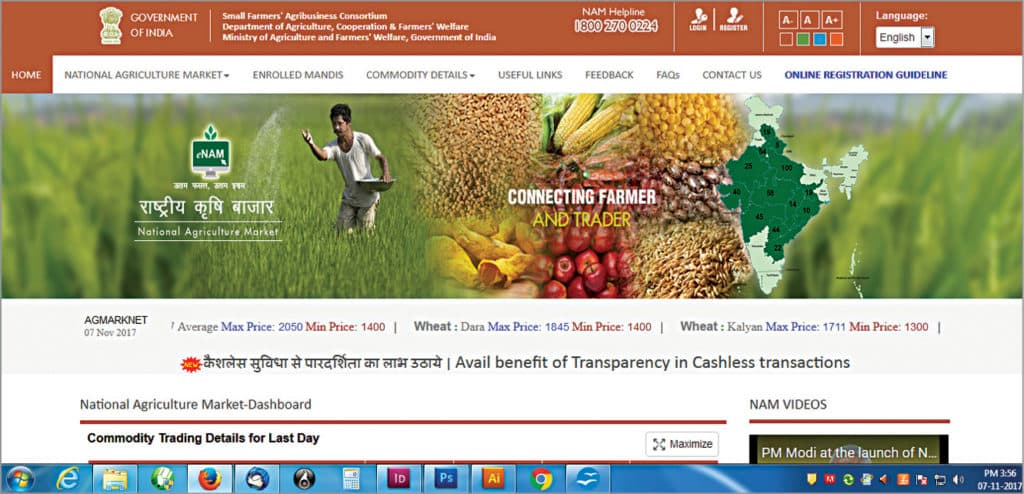India is fast becoming a hotbed for research on the Internet of Things (IoT), machine learning, artificial intelligence and more. The engineering and research community is optimistic that the country can do away with manual ways of doing things across various industries, speeding up the processes while also making them transparent.
One field that needs immediate intervention is agriculture and farming, where manual bureaucracy has denied farmers (more so marginal farmers) government-fixed prices for their produce.
How IoT and other smart concepts transform farming
“IoT is helpful in instantaneous collection of detailed data. The tracking of quantity, quality, time and price at various points of exchanges will help us to focus on areas of improvement,” states Dr Regi Mathew, data scientist at CleverInsight—a firm that is focused on leveraging the Internet of Things to transform businesses across the world.
Dr Regi believes that the right IoT-driven data collection mechanism will allow farmers (and the agricultural sector as a whole) to actually monitor the amount of produce that enters wholesale retailers.
Currently, most farmers still prefer middlemen (and agents) to find sales channels for their produce. This leads to a scenario wherein agents become price fixers and buy farmers’ produce at prices that are generally way below the market rates. Often, agents and middlemen quote insufficient supply or inferior quality of supply. This creates an artificial scarcity situation with respect to quantity and quality, leading to profit loss for farmers.
Creativity of embedded engineers and IoT service providers comes into play here, with respect to developing sensors that can monitor the amount of produce along with the quality of the supply in wholesale trading. Here, farmers should be offered technical insights in a simple manner so that they can gauge the end-results (in terms of quality of their produce) and directly deliver these to a wholesale retailer.
Farmers can be offered insights via mobile apps, and even text messages, after analytics is run on the data collected by sensors. Wholesale traders can directly connect with farmers after going through the agricultural data analysis (organised based on location as well) and revert with the current market prices. Thus middlemen are eliminated from the picture altogether.
Big Data: A ‘big’ advantage for farmers
“Agriculture production and distribution is an ideal case of Big Data application,” informs Dr Regi. This means that technologists should work on presenting the agriculturists with dashboards that are capable of tracking even the minutest aspects such as transportation costs from place A to place B.
Even demand prediction is an important advantage of Big Data and analytics over raw agriculture data.
“With Big Data applied, farmers can adjust their harvest based on the upcoming demand. If they have the right information, they can decide to sell immediately, store or preserve the produce in case it is perishable. Planting decisions can be made based on long-term forecasts,” advices Dr Regi.
In summary, Big Data and analytics empower farmers with the right knowledge to find easy and legal sales channels offering the best prices for their produce.
“During the times of actual produce scarcity, prices go up and farmers switch crops. This leads to abundance in the next cycle and price crash. The cycle repeats and farmers face crisis one after another. Such situations can be avoided if intelligence is shared with farmers in advance. The role of data analytics and Big Data is invaluable here.”
Smart marketplace models: The easiest to develop and deploy
Data scientists and IoT researchers believe that the easiest solution to the problem is deployment of smart marketplace models wherein farmers are constantly e-connected with companies interested in purchasing agricultural produce.
The biggest advantage of this system is that prevailing market prices are communicated dynamically to farmers via Big Data and analytics as soon as the conversation is initiated. This information included geographical location of the farm in which the produce is harvested, the fertility of the farm, prevalent weather conditions at the time of farming, and water sources.
This data is made available to farmers easily through a mobile application. Farmers can verify this ‘analysed’ data with government authorities. This eliminates the need of middlemen as exact prices are computed smartly.
For example, “GreenAgtech provides a platform to sell the harvest to HORECA (hotels, restaurants, cafe segment), who can place order via the app. After the purchase order is placed, the company supplies fruits and vegetables to the order placer. The best part about such a platform is that farmers get the best prices without time delays,” shares Shweta Gaded, business analyst at Bengaluru-based Inventrom (a company that develops and deploys Bolt Garo-IoT solution).
According to a seasoned technology professional (who offered insights on the condition of anonymity), apart from the agriculturist community, IoT researchers get to benefit the most as they get the opportunity to develop easily implementable IoT-driven agricultural solutions.
“Hire engineers by the lot to work for your agro-IoT startups. Implement sensors at the soil level. These sensors will send data that helps in determining a farmer’s future. Vital aspects such as soil quality, moisture level and temperature can be analysed through Big Data and analytics, and delivered (through text messages) to farmers as customised dashboards,” he advises agro-IoT startups.
Making existing markets smart
Though at a nascent stage, agro-IoT solutions are completely practical, feel embedded engineers.
IoT devices are not uncommon in marketplaces. These have seen the light of the day in several western economies. However, there are hitches. Geographical reach and connectivity with rural areas is still in its infancy in India. Marketplaces and fair-price shops are generally located 50-100 kilometres away from the farms where produce is harvested. So farmers still prefer middlemen to sell produce.
Nonetheless, Pune-based startup Ecozen has developed an IoT-driven solar-powered cold storage unit that is accessible even to small and marginal farmers. Tamil Nadu-based Nimble Wireless also offers IoT-driven cold chain solutions to both the food as well as pharma sectors.
“IoT machines allow users to alert their farm for a refill at the push of a button. So middlemen can definitely be eliminated. The onus is now on IoT service providers and embedded engineers to design and deploy such smart market devices,” adds Shweta.
Direct open source tools
There are open source platforms that directly connect farmers with traders. So, if you are an engineer intending to start farming on your ancestral land or simply a farmer, check out following open source platforms:
e-NAM
An online portal developed by the government of India for trading in agriculture produce, it promises to liberate farmers from the clutches of middlemen and realise fair market value for their yields.

ConnectFarmer
A common platform for processed farm products, it allows farmers to sell their produce directly to end users.
mKisan
Yet another buyer-seller platform created by the government of India, mKisan enables farmers to connect directly with buyers. Buyers register on this platform and choose the area from where they intend to buy the product. They can quote the price at which they want to procure a product. Farmers of the selected location get a text message on their mobile handset. This message contains name and mobile number of all interested buyers and the price offered to buy a commodity.
Government initiatives
The government’s interest in IoT and smart concepts has seemingly doubled. Together with Nasscom, it has formed the Centre of Excellence on the Internet of Things. This centre aims to further research on IoT across a plethora of domains such as smart cities and smart villages.
“The government is certainly taking necessary steps towards advancing the agriculture technologies and thereby making the life of farmers easier,” affirms Ravi Gupta, business analyst at Inventrom.

Other agro-IoT solutions by private players
Agro-IoT solutions have already been deployed at the ground level. A classic example here is the Inventrom Bolt, which is designed to effectively solve the farmers’ crop failure issues. It helps farmers with site-specific nutrient management with the help of sensors and environment for crop growth involving storage mapping, and soil quality checking.
Clients use Inventrom’s Bolt for a wide variety of applications including farmer profiling, crop monitoring and soil weather monitoring.
“Bolt can save losses due to crop failure. An efficient online marketplace and supply chain management is an optimal solution to enhance farmers’ produce sales,” signs off Swetha.
For more information on Bolt and its use-cases, readers may please visit the following link.










